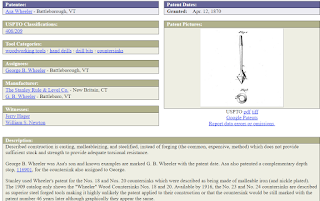Its from the seasonal flea market in Wilmot, same vendor from whom I have been getting some good braces and Hand drills lately. Including that mechanical marvel, the North Bros 1545, I sent to Gerhard. When I see her, now I just ask her what she got for tools and she shows me stuff she has not unpacked yet, for lack of space. I guess you can say, I get 1st dibs :-)
Today, when she shown me this brace, I was immediately taken aback how new it looked, yet, it is well made in the older tradition. No plastic, all metal, plated with wood (Beech, no stain, varnished), ball bearings in the head, ink markings almost perfect etc. For $20? Did not even bothered haggling for it, take my money please.
See anything wrong yet?
Footprint
Sheffield
England
Footprint ratchet brace
No 170
10 in sweep
BS1978
NO, that brace is not dated 1978, it reads British Standard (BS) 1978.
This just happened to be the BS for Hand Brace. The BS1978-1953 was later replaced by BS1978-1965 which is still current. That brace was more than likely made after 1965, still under that last edition of this standard.
With the old masking tape removed
wiped off with GOOGOO GONE.
It stink, but it is very efficient.
There is a faint discoloration under the tape,
it's been there for a while. It will gradually dissapeared under the UVs
The ratchet mechanism look pristine and work like a charm.
Good strong springs on the jaws
By now, you would be thinking, it's perfect right? I wrote about this before, but in the hunt for tools, we often overlook glaring defects or omissions, while being mesmerized by what you just found, you quickly develop selective blindness...
See it yet?
Huh? What is that gap??
What? I need a common and a Robertson Red screwdriver??
Obviously a prior Canadian Mod...
The plate is wavy, that is why the gap.
Notice the wrong size Robertson screw of the wrong type.
Its a tapered woodscrew versus a flat head commun slot screw
Not the first time removed for sure.
Now, this oversize Robertson wood screw and the gappy head were pretty glaringly obvious, how did I missed that ? All too easily :-)
So off to the stores I go to find some suitable screws.
Kinda got some, but not surprisingly, all the screws were Robertson heads... or were they... The UPC shows up when scanned as SQ-DR Argggg American inferior copies of Robertson being flogged upon an unsuspecting public....S.O.B
Anyway, for now all I have are a bunch of woodscrews with the right head but Robertson Green (?) versus slots, oh well, at least it is not so glaring anymore.
I'll keep looking, must have some, somewhere....
Hoh, and I flaten the platen. It was wavy allright. I simply squezzed it in a metal vice, line with a folded sheet of paper to protect the plated finish and rotate, squezze, rotate squezze etc until a lot more flat...
Removed screw, besides.
Now plate seat flush all around
The Footprint tools that we still know today, started with a merger in 1968, using that familiar footprint symbol. The company goes as far back as 1760 under the name Alfred Ridge & Sons. They are I believe one of the few remaining old Sheffield hand tools makers.
From the company website
All in all, this is a solid brace, practically unused and pristine except for a glaring booboo under the head, well worth the asking price. That one will probably go to one of my son's toolkit.
I better start making the tool boxes soon...
But thankfully, they each have a finite number of my Ahem, essential toolkit :-)
Bob, the blind tool hunter































































